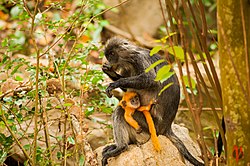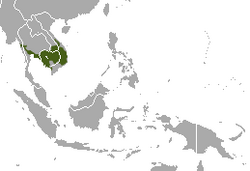Biology:Germain's langur
| Germain's langur[1] | |
|---|---|

| |
| Scientific classification | |
| Domain: | Eukaryota |
| Kingdom: | Animalia |
| Phylum: | Chordata |
| Class: | Mammalia |
| Order: | Primates |
| Suborder: | Haplorhini |
| Infraorder: | Simiiformes |
| Family: | Cercopithecidae |
| Genus: | Trachypithecus |
| Species group: | Trachypithecus cristatus group |
| Species: | T. germaini
|
| Binomial name | |
| Trachypithecus germaini (Milne-Edwards, 1876)
| |

| |
| Joint range of Germain's langur and Annamese langur | |
Germain's langur (Trachypithecus germaini)[1] is an Old World monkey native to Thailand, Myanmar, Cambodia, Laos and Vietnam.[3][2] The monkey was previously included in Trachypithecus cristatus[3] and Trachypithecus villosus.[2]
Two subspecies were recognized:[3]
- Trachypithecus germaini germaini
- Trachypithecus germaini caudalis
Taxonomy and evolution
Germain's langur is part of the leaf monkey subfamily Colobinae.[4] Two subspecies of the Germain's langur are recognized: Trachypithecus germaini germaini and Trachypithecus germaini caudalis.[4][5][6] However, the classification of the Germain's langur has been contested, with T. germaini being grouped with other species in its subfamily.[4][7] T. germaini and T. margarita were considered to be a single species, T. villosus, but morphological and genetic evidence has shown that they are distinct.[4][7][8][9] T. germaini has also been grouped with T. cristatus until recent reclassifications.[4]
Trachypithecus germaini goes by several common names such as the Indochinese lutung, Germain's langur, Germain's silver langur, Indochinese leaf monkey, and Indochinese silvered langur.[10]
Description
Germain's langur has black colouration on its hands and feet, as well as the upper part of its body which fades into paler grey on its underparts.[4] They have long grey tails and white hairs on its round face.[4] Their young have bright orange fur.[4]
Distribution and habitat
The limits of the distribution of Germain's langur are not well known, but they are currently found in Asia, specifically Cambodia, Vietnam, Lao PDR, Myanmar, and Thailand.[2] Populations in Vietnam are severely reduced, with few sightings in the last 50 years.[2][11] In Lao PDR, the species has no continuous range, rather multiple patches of higher relative abundance.[2][11] Its distribution in Cambodia is widespread, but its abundance will vary from common to rare.[2] One of the few sites with a population estimate is Keo Seima Wildlife Sanctuary where a stable population of 1487 is reported.[12][13] In Thailand, the species is common, with many protected areas supporting large populations.[2] Germain's langur is a terrestrial arboreal species, often found in lowlands.[2] They prefer evergreen and semi-evergreen, riverine, mixed deciduous, and gallery forests.[2] They are not commonly found at high elevations or hilly areas.[2]
Behaviour
The diet of Germain's langur is folivorous consisting of leaves, shoots, and fruits.[4][14] They are also observed to consume mushrooms (mycophagy) and soil (geophagy).[14] Their folivorous diet dictates a resting period, in which they can undergo the process of rumination.[14][15]
Trachypithecus germaini, and other Asian colobines, are generally less frequently engaged in social interaction than frugivorous primates such as macaques.[14][16] They have a lower affinity to social behaviour in comparison to feeding and resting which makes up the majority of their day.[14] However, T. germaini is often found in troops of 10 to 50 individuals in close social proximity.[4][14]
Predators and threats
Predators of Trachypithecus, including the Germain's langur, include leopards, tigers, dholes, and large snakes.[17] A variety of small carnivores will feed on the young.[17]
Prevalent threats to Germain's langur include hunting, exotic pet trading, and habitat loss due to agricultural expansion.[2]
Status and conservation
T. germaini is considered endangered by the IUCN, with a greater than 50% decline in the past three generations.[2] It is listed under CITES Appendix II, meaning that trade of the species must be controlled to avoid endangerment.[2][18]
Little conservation efforts have been made, despite the species designation.[7][14] Several protected areas have been established across its range which aids in the conservation of the species. The species has been recorded in numerous protected areas in Vietnam and Thailand.[2] In Vietnam, their populations have increased in two protected areas, Phú Quốc National Park and Kiên Lương Karst Area, demonstrating the importance of conservation efforts.[19]
References
- ↑ 1.0 1.1 Roos, C.; Boonratana, R.; Supriatna, J.; Fellowes, J.R.; Groves, C.P.; Nash, S.D.; Rylands, A.B.; Mittermeier, R.A. (2014). "An updated taxonomy and conservation status review of Asian primates". Asian Primates Journal 4 (1): 2–38. http://static1.1.sqspcdn.com/static/f/1200343/25106535/1403670682630/2014June24_APJ_Vol4_1.pdf?token=EY6Cm%2BAdyf9lSBug8Jv%2BeF%2B%2BPDM%3D. Retrieved 2018-08-30.
- ↑ 2.00 2.01 2.02 2.03 2.04 2.05 2.06 2.07 2.08 2.09 2.10 2.11 2.12 2.13 2.14 Duc, H.; Covert, H.; Ang, A.; Moody, J. (2021). "Trachypithecus germaini". IUCN Red List of Threatened Species 2021: e.T39874A195374767. doi:10.2305/IUCN.UK.2021-1.RLTS.T39874A195374767.en. https://www.iucnredlist.org/species/39874/195374767. Retrieved 19 November 2021.
- ↑ 3.0 3.1 3.2 Groves, C.P. (2005). Wilson, D.E.; Reeder, D.M.. eds. Mammal Species of the World: A Taxonomic and Geographic Reference (3rd ed.). Baltimore: Johns Hopkins University Press. p. 176. ISBN 0-801-88221-4. OCLC 62265494. http://www.departments.bucknell.edu/biology/resources/msw3/browse.asp?id=12100719.
- ↑ 4.0 4.1 4.2 4.3 4.4 4.5 4.6 4.7 4.8 4.9 Supanuam, Praween; Tanomtong, Alongklod; Khunsook, Sumpars; Khrueanet, Wilailuk; Pinthong, Krit; Wonkaonoi, Weeranuch (2015). "The First Report on Standardized Karyotype and Idiogram of Indochinese Silvered Langur, Trachypithecus germaini germaini (Primates, Colobinae) in Thailand" (in en). Cytologia 80 (2): 183–192. doi:10.1508/cytologia.80.183. ISSN 0011-4545. https://www.jstage.jst.go.jp/article/cytologia/80/2/80_183/_article.
- ↑ Parr, John W. K. (2003). A Guide to the Large Mammals of Thailand. Bangkok: Sarakadee Press. ISBN 974-484-040-4.
- ↑ Francis, Charles M. (2001). A photographic guide to mammals of Thailand & South-East Asia. Asia Books. OCLC 45914721.
- ↑ 7.0 7.1 7.2 Timmins, R. J.; Steinmetz, R.; Poulsen, M. K.; Evans, T. D.; Duckworth, J. W.; Boonratana, R. (2013). "The Indochinese Silvered Leaf Monkey Trachypithecus germaini ( Sensu lato ) in Lao PDR" (in en). Primate Conservation 26 (1): 75–87. doi:10.1896/052.026.0112. ISSN 0898-6207.
- ↑ Roos, C. (2008). "Mitochondrial phylogeny, taxonomy and biogeography of the silvered langur species group (Trachypithecus cristatus)". Molecular Phylogenetics and Evolution 47 (2): 629–636. doi:10.1016/j.ympev.2008.03.006. PMID 18406631.[|permanent dead link|dead link}}]
- ↑ Nadler, Tilo (2016). Rowe, Noel. ed. All the World's Primates. Pogonias Press. pp. 601–602. ISBN 978-1-940496-06-1.
- ↑ "Checklist of CITES species". http://checklist.cites.org/#/en/search/output_layout=alphabetical&level_of_listing=0&show_synonyms=1&show_author=1&show_english=1&show_spanish=1&show_french=1&scientific_name=Trachypithecus%20germaini&page=1&per_page=20.
- ↑ 11.0 11.1 Duckworth, William, ed (1999). Wildlife in Lao PDR: 1999 status report. World Conservation Union. ISBN 2-8317-0483-9. OCLC 799695132.
- ↑ Nuttall, Matthew N.; Griffin, Olly; Fewster, Rachel M.; McGowan, Philip J. K.; Abernethy, Katharine; O'Kelly, Hannah; Nut, Menghor; Sot, Vandoeun et al. (2022). "Long-term monitoring of wildlife populations for protected area management in Southeast Asia" (in en). Conservation Science and Practice 4 (2): e614. doi:10.1111/csp2.614. ISSN 2578-4854.
- ↑ Griffin, O.; Nuttall, M. (2020-12-04) (in en-US). Status of Key Species in Keo Seima Wildlife Sanctuary 2010-2020 (Report). doi:10.19121/2020.Report.38511. https://library.wcs.org/Scientific-Research/Research-Publications/Publications-Library/ctl/view/mid/40093/pubid/DMX3851100000.aspx.
- ↑ 14.0 14.1 14.2 14.3 14.4 14.5 14.6 de Groot, Brenda; Nekaris, Anna (2016). "Ecology of the Germain's Langur Trachypithecus germaini in a Pre-release Environment and the Implications for its conservation". Asian Primates Journal 6 (1). http://www.primate-sg.org/storage/asian-primates-journal/volume-61/2016Sep23_Article_1.pdf. Retrieved 30 December 2023.
- ↑ Korstjens, Amanda H.; Lehmann, Julia; Dunbar, R.I.M. (2010). "Resting time as an ecological constraint on primate biogeography". Animal Behaviour 79 (2): 361–374. doi:10.1016/j.anbehav.2009.11.012. ISSN 0003-3472.
- ↑ Kirkpatrick, R.C. 2011. The Asian colobines: diversity among leaf-eating monkeys. In: Primates in Perspective, C.J. Campbell, A. Fuentes, K.C. MacKinnon and M. Panger (eds.), pp. 189–202. Oxford University Press, Oxford, UK.
- ↑ 17.0 17.1 Harding, Lee E. (2010-01-25). "Trachypithecus cristatus (Primates: Cercopithecidae)" (in en). Mammalian Species 42: 149–165. doi:10.1644/862.1. ISSN 0076-3519.
- ↑ "How CITES works | CITES". https://www.cites.org/eng/disc/how.php.
- ↑ Van Tran, Bang; Nguyen, Minh Anh; Nguyen, Dat Quoc; Truong, Quan Bich Thi; Ang, Andie; Covert, Herbert H.; Hoang, Duc Minh (2017). "Current conservation status of Germain's langur (Trachypithecus germaini) in Vietnam" (in en). Primates 58 (3): 435–440. doi:10.1007/s10329-017-0610-2. ISSN 0032-8332. PMID 28492971.
Wikidata ☰ Q1202908 entry
 |


